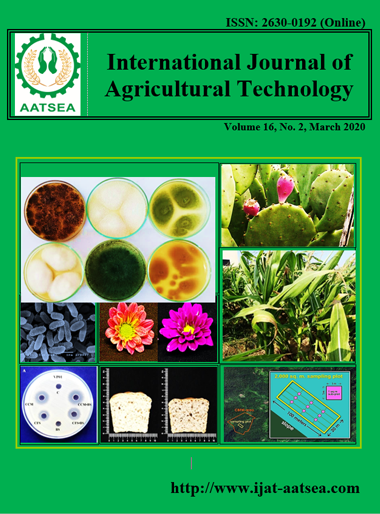Influence of sex, age, slaughter mass and source farm on carcass composition of fattening dairy cattle
Main Article Content
Abstract
Sex significantly influenced total tendons mass and percentage of tendons mass (P<0.01). The factor had also significantly affected to total mass, total lean meat mass and total bone mass (P<0.05). Age influenced total bone mass, total fat mass, percentage of bone and muscle:fat ratio (P<0.05) and proportion of fat (P<0.01). Chilled carcass mass, total mass of lean meat, bone, fat, and tendons were highly significantly affected by slaughter mass (P<0.01), which also significantly influenced percentage of fat (P<0.05). Cattle with a slaughter mass more than 650 kg had higher averages of chilled carcass mass, total lean meat, bone, fat, and tendon mass and percentage of fat than lighter animals. The factor of source farm significantly effected chilled carcass mass and total fat mass (P<0.01), as well as total mass of lean meat and bone and percentages of bone and of fat (P<0.05).
Article Details

This work is licensed under a Creative Commons Attribution-NonCommercial-NoDerivatives 4.0 International License.
References
ACFS (2004). Thai Agricultural Community and Food Standard TACFS 6001-2547. Ministry of Agriculture and Cooperative, Bangkok, pp. 13.
Chainam, J., Opatpatanakit, Y., Kiatbenjakul, P., Lin, R. S. and Kiratikarnkul, S. (2019). Carcass Characteristics, Meat quality and eating quality of culled dairy cows. Science and Technology Asia Journal, 24:47-58.
Guerrero, A., Valero, M. V., Campo, M. M. and Sañudo, C. (2013). Some factors that affect ruminant meat quality: from the farm to the fork. Review. 2013. Acta Scientiarum Animal Sciences, 35:335-347.
Irshad A., Kandeepan G., Kumar S., Ashish Kumar A., Vishnuraj M. R. and Shukla, V. (2013). Factors Influenceing Carcass Composition of Livestock: a Review. Journal of Animal Production Advances, 3:177-186.
Noidad, S., Lertpatarakomol, R. and Rakthong, M. (2014). Preliminary study on carcass quality of culled dairy cows. The 5th Meat Science Technology, Bangkok, pp.116.
OAE (2018). Office of Agricultural Economics. Retrieved from http://dairydevelop mentprogram.weebly.com/blog- 36153634361936603617362636403586/-2562.
SAS (1999). SAS/STAT User’s Guide: Statistic, SAS Institute Inc. North Carolina.
Sethakul, J. (2016). Fattening dairy beef: the opportunity to entering in market quality beef. In Seminar of Fattening Dairy Beef: Opportunity and Preparedness in Beef Shortage Crisis, Meajo University, Chiang Mai, pp. 1-7.
Supphakitchanon, T., Pattanawong, W., Kiratikrankul, B. and Chainam, J. (2015). Systemic management for quality meat production from cull dairy cow. Retrieved from https://elibrary.trf.or.th/downloadFull.asp?proid= PDG6120003.
Tavitchasri, P., Kanloung, T., Phonmum, T., Prachachet, N. and Ngamyeesoon, N. (2016). A comparison of carcass traits between Charolais and Culled Holstein-Friesian Crossbred in different slaughter mass and age. 63rd International Congress of Meat Science and Technology, Cork, pp.101.
Tuntivisoottikul, K. and Limsupavanich, R. (2018). Effects of gender of dairy or beef cattle and the number of pair of permanent incisors on carcass traits. MATEC Web of Conferences, 192:03050.


